 W
WAcropora aculeus is a species of acroporid corals found throughout the Indian Ocean, the central Indo-Pacific, Australia, southeast Asia, Japan and the East China Sea. It is also present in the western Pacific Ocean. It is an uncommon species and is particularly prone to coral bleaching, disease, and crown-of-thorns starfish predation; it is also harvested for use in aquaria, and the International Union for Conservation of Nature has assessed it as being a "vulnerable species". Habitat loss is a big concern.
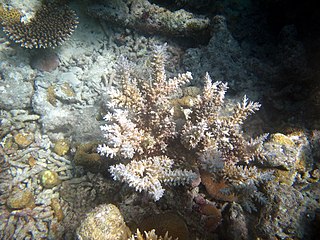 W
WAcropora echinata is a species of acroporid coral that was first described by Dana in 1846. Found in shallow, tropical, sheltered reefs in marine environments, it is found at depths of 8 to 25 m in clear water. The species is listed as vulnerable on the IUCN Red List, and has a decreasing population. It is not common but found over a large area, and is listed under CITES Appendix II.
 W
WAcropora globiceps is a species of acroporid coral found in the oceanic central and western Pacific Ocean and central Indo-Pacific. It can also be found in the Great Barrier Reef, the Philippines, the Andaman Islands, Polynesia, Micronesia and the Pitcairn Islands. It occurs on the slopes of reefs, the flats of reefs, in tropical shallow reefs, and at depths of around 8 metres (26 ft). It was described by Dana in 1846.
 W
WAcropora horrida is a species of acroporid coral that was first described by James Dwight Dana in 1846. Found in tropical, shallow reefs in marine environments, it occurs near fringing reefs around turbid water, at depths of 5 to 20 m. It is listed as a vulnerable species on the IUCN Red List, and it is thought to have a decreasing population. It is not common and found over a large area, and is listed under CITES Appendix II.
 W
WAcropora microclados is a species of acroporid coral that was first described by Christian Gottfried Ehrenberg in 1834. Found in marine, tropical shallow reefs on the upper slopes, it is found at depths of 5 to 20 m. It is listed as a vulnerable species on the IUCN Red List, and its population is decreasing. It is uncommon but found over a large area, including in five regions of Indonesia, and is classified under CITES Appendix II.
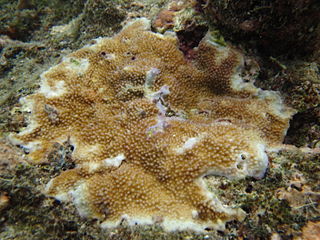 W
WAcropora palmerae is a species of acroporid coral found in the northern Indian Ocean, the central Indo-Pacific, Australia, Southeast Asia, Japan, the East China Sea and the oceanic west Pacific Ocean. It is also found in Palau and the Mariana Islands, American Samoa, the Andaman Islands, the Great Barrier Reef, Okinawa Island, Mauritius, Micronesia, the Cook Islands and the Philippines. It occurs in tropical shallow reefs on flats exposed the action of strong waves and in lagoons, from depths of 0 to 12 metres. It was described by Wells in 1954.
 W
WAcropora valida is a species of acroporid coral found in the Red Sea, the Gulf of Aden, the southwestern, northwestern and northern Indian Ocean, the Persian Gulf, the central Indo-Pacific, Australia, southeast Asia, Japan, the East China Sea, the oceanic western, central and far eastern Pacific Ocean, the northwestern Hawaiian Islands and Johnston Atoll. It occurs in tropical shallow reefs in a variety of reef habitats, at depths of 1 to 15 metres.
 W
WAcropora vaughani is a species of acroporid coral found in the northern Indian Ocean, the central Indo-Pacific, Australia, southeast Asia, Japan, the East China Sea and the oceanic western and central Pacific Ocean. It is also found in Madagascar. It occurs in tropical shallow reefs around fringing reefs in turbid water, at depths of between 3 and 20 metres. It was described by J. W. Wells in 1954.
 W
WAcropora verweyi is a species of acroporid coral found in the southwest and northern Indian Ocean, the central Indo-Pacific, Australia, southeast Asia, Japan, the East China Sea and the oceanic western Pacific Ocean. It is also found in the Philippines, American Samoa, Fiji and Rodrigues. It occurs in tropical shallow reefs on upper slopes, from depths of 2 to 15 metres.
 W
WThe Ceram fruit bat or Seram flying fox is a species of megabat in the family Pteropodidae. It is endemic to the mountainous forests of two Indonesian islands, Buru and Seram, including the Manusela National Park on Seram. They were once present on the nearby Ambon Island, but probably not anymore. The habitat has an area of less than 20,000 km2, and is decreasing due to logging. For this reason, and because of hunting by the local population, these species are listed as vulnerable by the IUCN since 1996.
 W
WFardoulis's blossom bat is a species of bat in the Pteropodidae family. It is endemic to the Solomon Islands. Its natural habitat is subtropical or tropical moist lowland forests. It is threatened by habitat loss.
 W
WThe lesser tube-nosed bat is a species of megabat in the family Pteropodidae. It is native to two of the Maluku Islands in northern Indonesia.
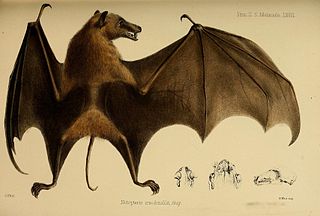 W
WThe long-tailed fruit bat, long-tailed blossom bat, or Fijian blossom bat is a species of megabat in the family Pteropodidae. It is found in Fiji and Vanuatu. They roost as large colonies in caves and forage in a range of lowland and montane habitats. It is threatened by exploitation and disturbance of its roosting caves, hunting, and tourism.
 W
WThe Makira roundleaf bat is a species of bat in the family Hipposideridae endemic to the Solomon Islands.
 W
WThe New Zealand long-tailed bat, also known as the long-tailed wattled bat or pekapeka-tou-roa (Māori), is one of 15 species of bats in the genus Chalinolobus variously known as "pied bats", "wattled bats" or "long-tailed bats". It is one of the two surviving bat species endemic to New Zealand, but is closely related to five other wattled or lobe-lipped bats in Australia and elsewhere.
 W
WThe Papuan sheath-tailed bat is a species of bat in the family Emballonuridae which occurs at the Cape York Peninsula and New Guinea. The poorly known species hunts in open forests for night flying insects.
 W
WThe bigeye thresher is a species of thresher shark, family Alopiidae, found in temperate and tropical oceans worldwide. Like other thresher sharks, nearly half its total length consists of the elongated upper lobe of the tail fin. Its common name comes from its enormous eyes, which are placed in keyhole-shaped sockets that allow them to be rotated upward. This species can also be distinguished by a pair of deep grooves on the top of its head, from which its scientific name is derived.
 W
WThe Christmas boobook, also known more specifically as the Christmas Island hawk-owl, is a species of owl in the family Strigidae.
 W
WDactylanthus taylorii, commonly known as wood rose, is a fully parasitic flowering plant, the only one endemic to New Zealand. The host tree responds to the presence of Dactylanthus by forming a burl-like structure that resembles a fluted wooden rose. When the flowers emerge on the forest floor, they are pollinated by a ground-foraging species of native bat.
 W
WThe Fiordland penguin, also known as the Fiordland crested penguin, is a crested penguin species endemic to New Zealand. It currently breeds along the south-western coasts of New Zealand's South Island as well as on Stewart Island/Rakiura and its outlying islands. Because it originally ranged beyond Fiordland, it is sometimes referred to as the New Zealand crested penguin.
 W
WThe dwarf flying fox, least flying fox, or least fruit bat is a species of flying fox in the family Pteropodidae. It is endemic to the Solomon Islands. It is threatened by deforestation, which is believed to damage roosting sites in old growth forests.
 W
WThe Geelvink Bay flying fox or Geelvink Bay fruit bat is a species of flying fox in the family Pteropodidae. It is endemic to West Papuan islands in Indonesia. The name comes from Geelvink Bay, now Cenderawasih Bay. It is common over a small area, and the population trend is decreasing. Major threats to the species are loss of habitat due to timber harvesting, and hunting.
 W
WTemminck's flying fox is a species of flying fox in the family Pteropodidae. It is found in Indonesia. The species was classified as "Vulnerable" in 2008 by the IUCN due to threats from habitat destruction and hunting.
 W
WThe Vanuatu flying fox or white flying fox is a species of flying fox in the family Pteropodidae. It is endemic to Vanuatu. It is most closely related to the Samoa flying fox.
 W
WThe smooth hammerhead is a species of hammerhead shark, and part of the family Sphyrnidae. This species is named "smooth hammerhead" because of the distinctive shape of the head, which is flattened and laterally extended into a hammer shape, without an indentation in the middle of the front margin. Unlike other hammerheads, this species prefers temperate waters and occurs worldwide at medium latitudes. In the summer, these sharks migrate towards the poles following cool water masses, sometimes forming schools numbering in the hundreds to thousands.
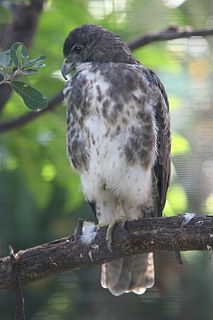 W
WThe Hawaiian hawk or ʻio is a raptor of the Buteo genus endemic to Hawaiʻi, currently restricted to the Big Island. Buteos tend to be easily recognized by their bulky bodies relative to their overall length and wingspan. The ʻio is the only hawk that is native to Hawaiʻi, and fossil evidence indicates that it inhabited the island of Hawaiʻi, Molokaʻi, Oʻahu, and Kauaʻi at one time. Today, it is known to breed only on the Big Island, in stands of native ʻōhiʻa lehua trees. The species was protected as an endangered species in the United States, but was delisted in 2020. However, the IUCN classifies the species as Near Threatened.
 W
WHeliofungia actiniformis is a solitary species of mushroom coral, a large polyp stony coral in the family Fungiidae. This coral is found in shallow water in the Indo-Pacific region. It is a zooxanthellate species. It is a popular coral in the reef aquarium trade; wild populations are threatened by disease, climate change, and over-collecting, and the species is considered vulnerable by the IUCN.
 W
WHippocampus kuda, also known as the common seahorse, estuary seahorse, yellow seahorse or spotted seahorse is a seahorse of the family Syngnathidae native to the Indo-Pacific. The common name sea pony has been used for this species under its synonym Hippocampus fuscus.
 W
WThe leatherback sea turtle, sometimes called the lute turtle or leathery turtle or simply the luth, is the largest of all living turtles and is the fourth-heaviest modern reptile behind three crocodilians. It is the only living species in the genus Dermochelys and family Dermochelyidae. It can easily be differentiated from other modern sea turtles by its lack of a bony shell, hence the name. Instead, its carapace is covered by skin and oily flesh.
 W
WThe ʻanianiau, pronounced, is a species of Hawaiian honeycreeper that is endemic to upper elevation forests on the island of Kauai.
 W
WThe Moluccan flying fox, also known as the Ambon flying fox, is a species of megabat in the genus Pteropus.
 W
WThe tawny nurse shark is a species of carpet shark in the family Ginglymostomatidae, and the only extant member of the genus Nebrius.
 W
WThe New Caledonia blossom bat is an uncommon species of megabat in the family Pteropodidae. The species lives in caves in northern New Caledonia, and forms colonies of up to 300.
 W
WThe New Caledonia catshark or Kanakorum catshark is a catshark of the family Scyliorhinidae in the order Carcharhiniformes, known only from one specimen collected near southwestern New Caledonia in the western central Pacific Ocean. The holotype measured 79 cm (31 in). The New Caledonia catshark is a rare and vulnerable inshore catshark found around coral reefs.
 W
WThe New Zealand rock wren is a small New Zealand wren endemic to the South Island of New Zealand. Its Māori names include pīwauwau, mātuitui, and tuke. Outside New Zealand it is sometimes known as the rockwren or South Island wren to distinguish it from the unrelated rock wren of North America.
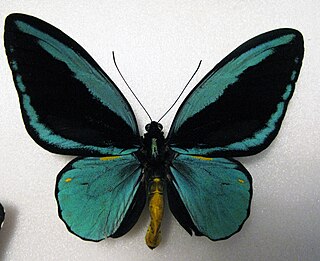 W
WOrnithoptera aesacus, the Obi Island birdwing, is a rare species of birdwing butterfly, endemic to the Island of Obira, Indonesia.
 W
WThe black-lored parrot also known as the Buru green parrot, is a parrot endemic to the Indonesian island of Buru. It is a 40 cm (16 in) long green parrot with black lores, and a turquoise crown. Males have red beaks, and females are gray-brown. The singing is high pitched and more protracted as compared to similar species, such as great-billed parrot.
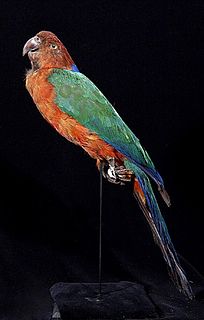 W
WThe crimson shining parrot is a parrot from Fiji. The species is endemic to the islands of Kadavu and Ono in the Kadavu Group. The species was once considered conspecific with the red shining parrot of Vanua Levu and Taveuni, but is now considered its own species. The species is sometimes known as the Kadavu musk parrot.
 W
WThe reef manta ray is a species of ray in the family Mobulidae, one of the largest rays in the world. Among generally recognized species, it is the second-largest species of ray, only surpassed by the giant oceanic manta ray.
 W
WRothschild's birdwing is a large birdwing butterfly, endemic to the Arfak Mountains in Western New Guinea.
 W
WThe New Zealand king shag, also known as the rough-faced shag, king shag or kawau, is a rare bird endemic to New Zealand. Some taxonomic authorities, including the International Ornithologists' Union, place this species in the genus Leucocarbo. Others place it in the genus Phalacrocorax.
 W
WThe dusky shark is a species of requiem shark, in the family Carcharhinidae, occurring in tropical and warm-temperate continental seas worldwide. A generalist apex predator, the dusky shark can be found from the coast to the outer continental shelf and adjacent pelagic waters, and has been recorded from a depth of 400 m (1,300 ft). Populations migrate seasonally towards the poles in the summer and towards the equator in the winter, traveling hundreds to thousands of kilometers. One of the largest members of its genus, the dusky shark reaches 4.2 m (14 ft) in length and 347 kg (765 lb) in weight. It has a slender, streamlined body and can be identified by its short round snout, long sickle-shaped pectoral fins, ridge between the first and second dorsal fins, and faintly marked fins.
 W
WThe school shark is a houndshark of the family Triakidae, and the only member of the genus Galeorhinus. Common names also include tope shark, snapper shark, and soupfin shark. It is found worldwide in temperate seas at depths down to about 800 m (2,600 ft). It can grow to nearly 2 m long. It feeds both in midwater and near the seabed, and its reproduction is ovoviviparous. This shark is caught in fisheries for its flesh, its fins, and its liver, which has a very high vitamin A content. The IUCN has classified this species as critically endangered in its Red List of Threatened Species.
 W
WThe tawny nurse shark is a species of carpet shark in the family Ginglymostomatidae, and the only extant member of the genus Nebrius.
 W
WThe oceanic whitetip shark, also known as Brown Milbert's sand bar shark, brown shark, lesser white shark, nigano shark, oceanic white-tipped whaler, and silvertip shark, is a large pelagic requiem shark inhabiting tropical and warm temperate seas. Its stocky body is most notable for its long, white-tipped, rounded fins.
 W
WThe short-tailed albatross or Steller's albatross is a large rare seabird from the North Pacific. Although related to the other North Pacific albatrosses, it also exhibits behavioural and morphological links to the albatrosses of the Southern Ocean. It was described by the German naturalist Peter Simon Pallas from skins collected by Georg Wilhelm Steller. Once common, it was brought to the edge of extinction by the trade in feathers, but with protection has recently made a recovery.
 W
WThe snaggletooth shark, or fossil shark, is a species of weasel shark in the family Hemigaleidae, and the only extant member of the genus Hemipristis. It is found in the Indo-West Pacific, including the Red Sea, from southeast Africa to the Philippines, north to China, and south to Australia, at depths from 1 to 130 metres. This shark can be found near the bottom of the water column of coastal areas, but can be found at continental and insular shelves. Its length is up to 240 cm (7.87 ft). Despite being only vulnerable to extinction, this shark is very rarely seen.
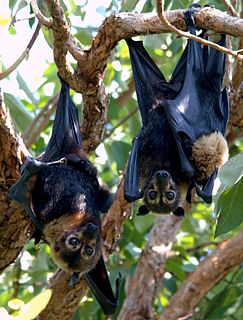 W
WThe spectacled flying fox, also known as the spectacled fruit bat, is a megabat that lives in Australia's north-eastern regions of Queensland. It is also found in New Guinea and on the offshore islands including Woodlark Island, Alcester Island, Kiriwina, and Halmahera.
 W
WThe smalltooth sand tiger or bumpytail ragged-tooth is a species of mackerel shark in the family Odontaspididae, with a patchy but worldwide distribution in tropical and warm temperate waters. They usually inhabit deepwater rocky habitats, though they are occasionally encountered in shallow water, and have been known to return to the same location year after year. This rare species is often mistaken for the much more common grey nurse shark, from which it can be distinguished by its first dorsal fin, which is larger than the second and placed further forward. It grows to at least 4.1 m (13.5 ft) in length.
 W
WDoria's tree-kangaroo is a tree-kangaroo endemic to Papua New Guinea.
 W
WThe grizzled tree-kangaroo is a small arboreal species of marsupial in the family Macropodidae. It is found in foothill forests of northern and western New Guinea and is indigenous to some of the offshore islands.
 W
WThe lowlands tree-kangaroo or lowland tree-kangaroo is a species of tree-kangaroo in the family Macropodidae.
 W
WThe ursine tree-kangaroo is a species of marsupial in the family Macropodidae. It is endemic to the Vogelkop and possibly the Fakfak Peninsulas, West Papua, Indonesia. Other common names for this species include the black tree-kangaroo, the Vogelkop tree-kangaroo and the white-throated tree-kangaroo. It is threatened by habitat destruction and is listed as "vulnerable" by the International Union for Conservation of Nature.
 W
WThe pink whipray is a species of stingray in the family Dasyatidae, with a wide but ill-defined distribution in the tropical Indo-Pacific from southern Africa to Polynesia. It is a bottom dweller that generally inhabits shallow water under 70 m (230 ft) deep, in sandy areas associated with coral reefs. Individuals exhibit a high degree of fidelity to particular locations. The pink whipray has a diamond-shaped pectoral fin disc wider than long, with a broad-angled snout and a very long, whip-like tail without fin folds. It has only a few small thorns on its back and is uniform brownish to grayish pink in color, becoming much darker past the tail sting. This large ray can reach 1.8 m (5.9 ft) across and over 5 m (16 ft) long.